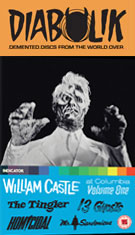
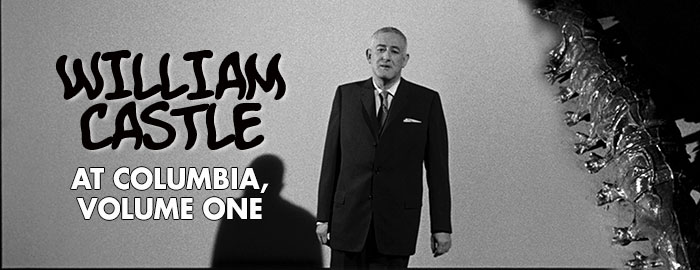
THE TINGLER
B&W/Color, 1959, 81 mins. 30 secs.
Directed by William Castle
Starring Vincent Price, Judith Evelyn, Darryl Hickman, Patricia Cutts, Pamela Lincoln
Indicator (Blu-ray) (UK R0 HD), Scream Factory (Blu-ray) (US RA HD), i-catcher (Blu-ray & DVD) (Germany RB/R2 HD/PAL), Sony (DVD) (US R0 NTSC) / WS (1.85:1) (16:9)
13 GHOSTS
B&W/Color, 1960, 84 mins. 28 secs. / 82 mins. 12 secs.
Directed by William Castle
Starring Donald Woods, Martin Milner, Rosemary DeCamp, Jo Morrow, Charles Herbert, Margaret Hamilton
Indicator (Blu-ray) (UK R0 HD), Mill Creek (Blu-ray) (US RA HD), Sony (DVD) (US R0 NTSC) / WS (1.85:1) (16:9)
HOMICIDAL
B&W, 1961, 87 mins. 23 secs.
Directed by William Castle
Starring Glenn Corbett, Patricia Breslin, Jean Arless, Eugenie Leontovich, Alan Bunce, Richard Rust
Indicator (Blu-ray) (UK R0 HD), Mill Creek (Blu-ray) (US RA HD), Sony (DVD) (US R0 NTSC) / WS (1.85:1) (16:9)
MR. SARDONICUS
B&W, 1961, 89 mins. 57 secs.
Directed by William Castle
Starring Guy Rolfe, Ronald Lewis, Oscar Homolka, Audrey Dalton
Indicator (Blu-ray) (UK R0 HD), Mill Creek (Blu-ray) (US RA HD), Sony (DVD) (US R0 NTSC) / WS (1.85:1) (16:9)
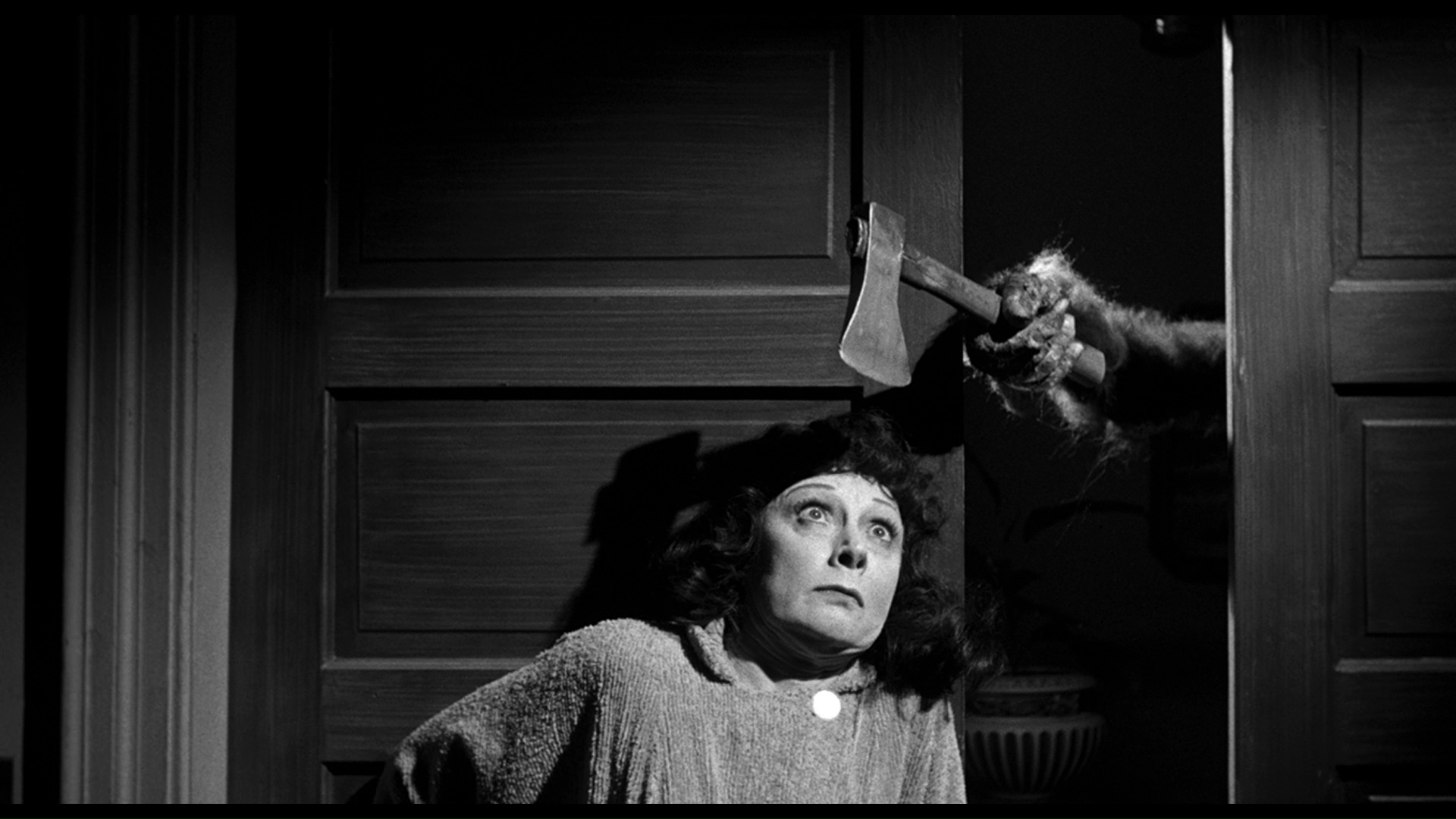 he had
he had 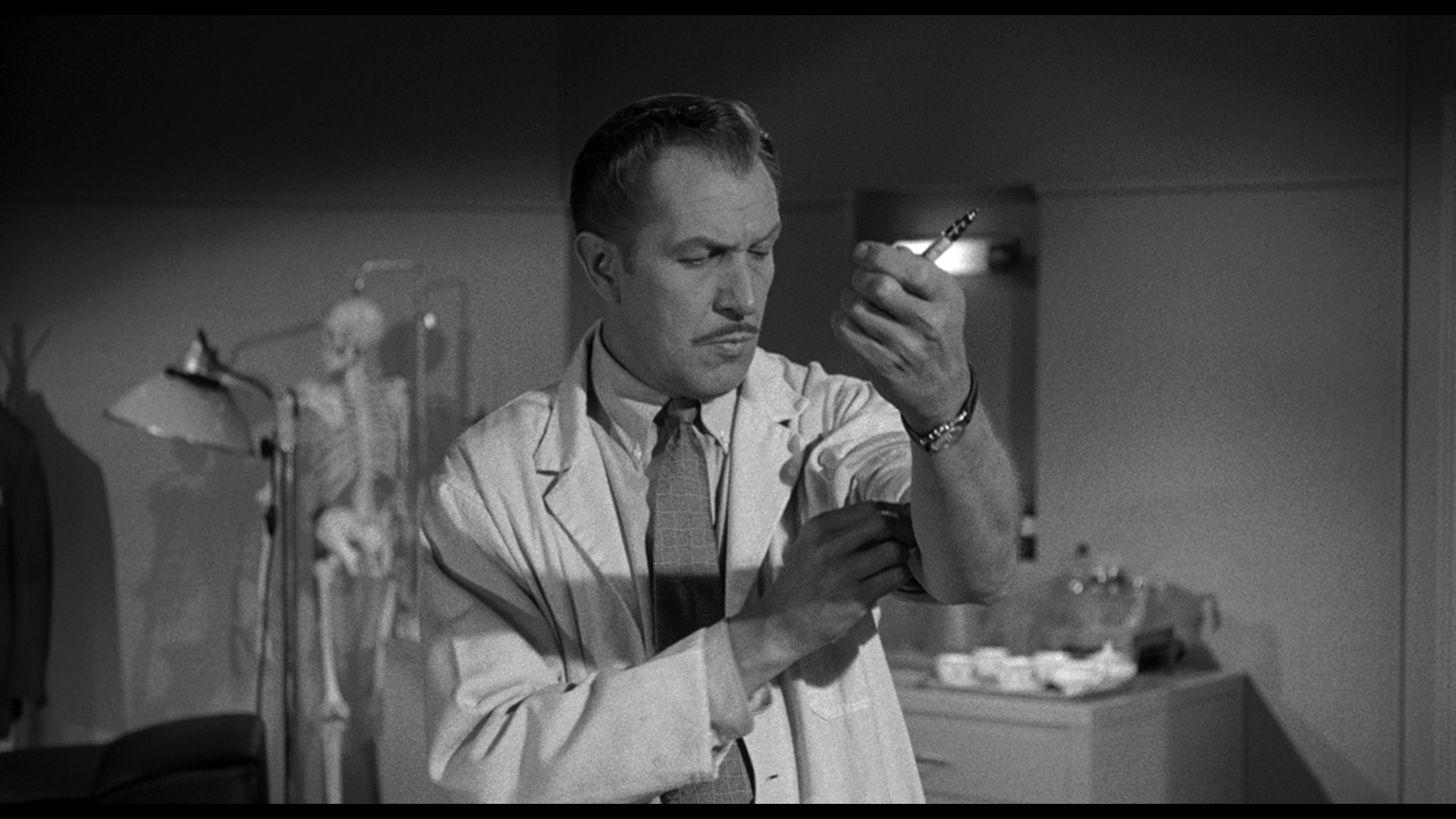 long been working at Columbia Pictures including a string of mysteries and westerns, director William Castle wasn't there at the start of the most famous period of his career as a brilliant horror showman. In 1958 he went to Allied Artists for his first gimmick-driven shocker, Macabre, which offered an insurance policy for death by fright -- and that was enough to pack in eager viewers for its taut story of kidnapping and murder told in real time. He stayed at Allied Artists for his first starring vehicle for Vincent Price, House on Haunted Hill, which introduced Emergo (a skeleton trotted out over the audience) and remains one of the greatest Halloween films of all time. By that point Castle was primed to return to Columbia with guns blazing, kicking off a six-year series of ingenious productions that remain compulsively watchable and thematically fascinating. The first four of these are collected in the 2018 U.K. Blu-ray box from Indicator (a second one covers the rest of his genre output there), all beautifully presented.
long been working at Columbia Pictures including a string of mysteries and westerns, director William Castle wasn't there at the start of the most famous period of his career as a brilliant horror showman. In 1958 he went to Allied Artists for his first gimmick-driven shocker, Macabre, which offered an insurance policy for death by fright -- and that was enough to pack in eager viewers for its taut story of kidnapping and murder told in real time. He stayed at Allied Artists for his first starring vehicle for Vincent Price, House on Haunted Hill, which introduced Emergo (a skeleton trotted out over the audience) and remains one of the greatest Halloween films of all time. By that point Castle was primed to return to Columbia with guns blazing, kicking off a six-year series of ingenious productions that remain compulsively watchable and thematically fascinating. The first four of these are collected in the 2018 U.K. Blu-ray box from Indicator (a second one covers the rest of his genre output there), all beautifully presented. sensation people experience in situations of mounting fear. His gold-digging wife, Isabel (Cutts, doing a funny impersonation of Grace Kelly gone bad),
sensation people experience in situations of mounting fear. His gold-digging wife, Isabel (Cutts, doing a funny impersonation of Grace Kelly gone bad), 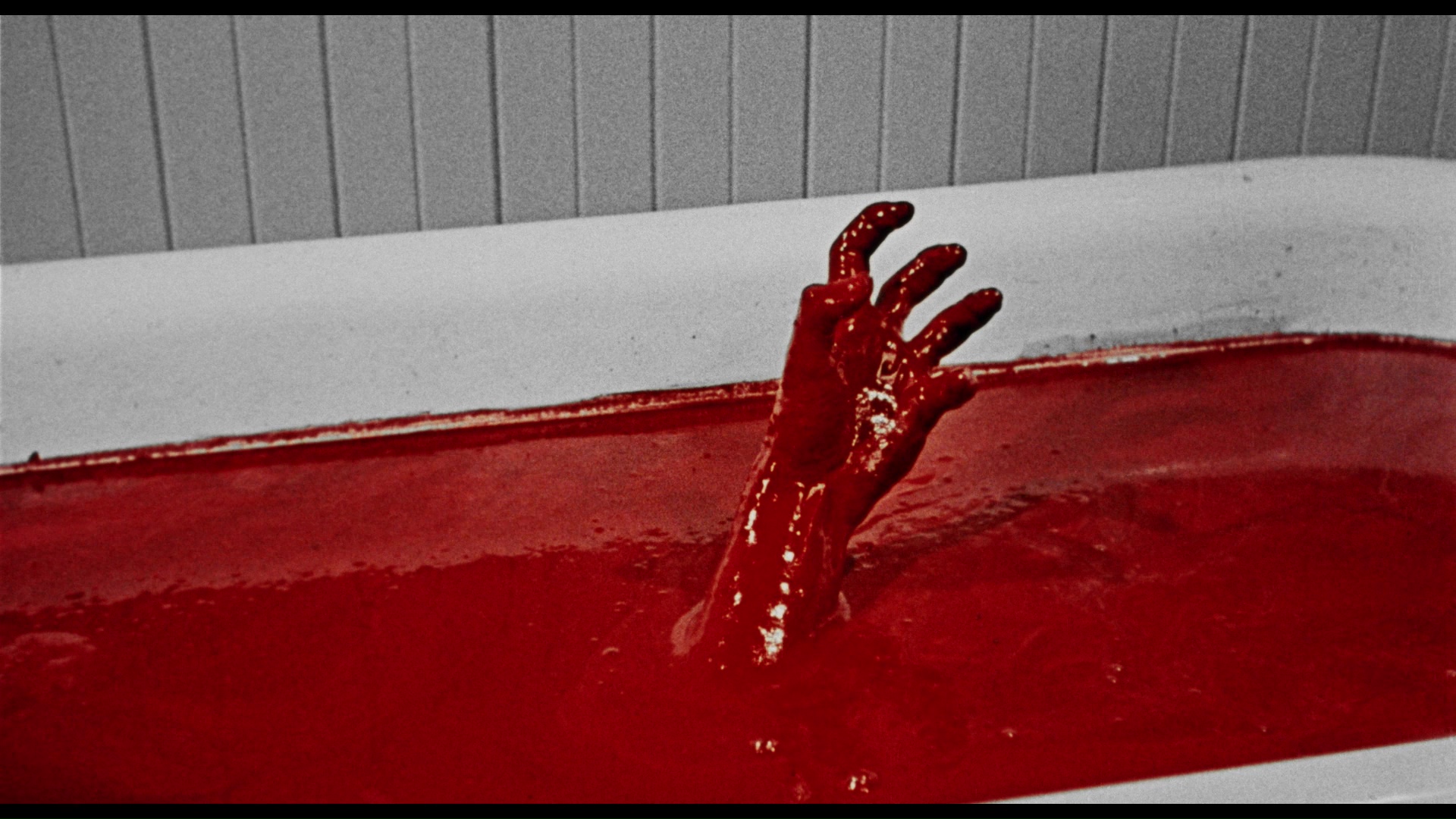 scoffs at his notions and occasionally plans to murder him, just for the hell of it. However, Warren's assistant, David (Hickman), takes these studies more seriously as the good doctor uses any means at his disposal to further his studies. Warren pretends to kill his wife, causing her to faint, and the subsequent X-rays reveal that the tingler is actually a strange, lobster-shaped creature which feeds on terror and grows at the base of the spine. The doc shoots up with LSD (apparently a screen first) to create a mindset of unrestrained hysteria, but he expresses his anguish with a scream, presumably the release which paralyzes this beast. Martha (Evelyn), a deaf mute movie theater owner who only shows silent films, provides an important find in the research process, but when our heroes find a real live extracted tingler on their hands, matters veer wildly out of control... and the fun really begins.
scoffs at his notions and occasionally plans to murder him, just for the hell of it. However, Warren's assistant, David (Hickman), takes these studies more seriously as the good doctor uses any means at his disposal to further his studies. Warren pretends to kill his wife, causing her to faint, and the subsequent X-rays reveal that the tingler is actually a strange, lobster-shaped creature which feeds on terror and grows at the base of the spine. The doc shoots up with LSD (apparently a screen first) to create a mindset of unrestrained hysteria, but he expresses his anguish with a scream, presumably the release which paralyzes this beast. Martha (Evelyn), a deaf mute movie theater owner who only shows silent films, provides an important find in the research process, but when our heroes find a real live extracted tingler on their hands, matters veer wildly out of control... and the fun really begins. 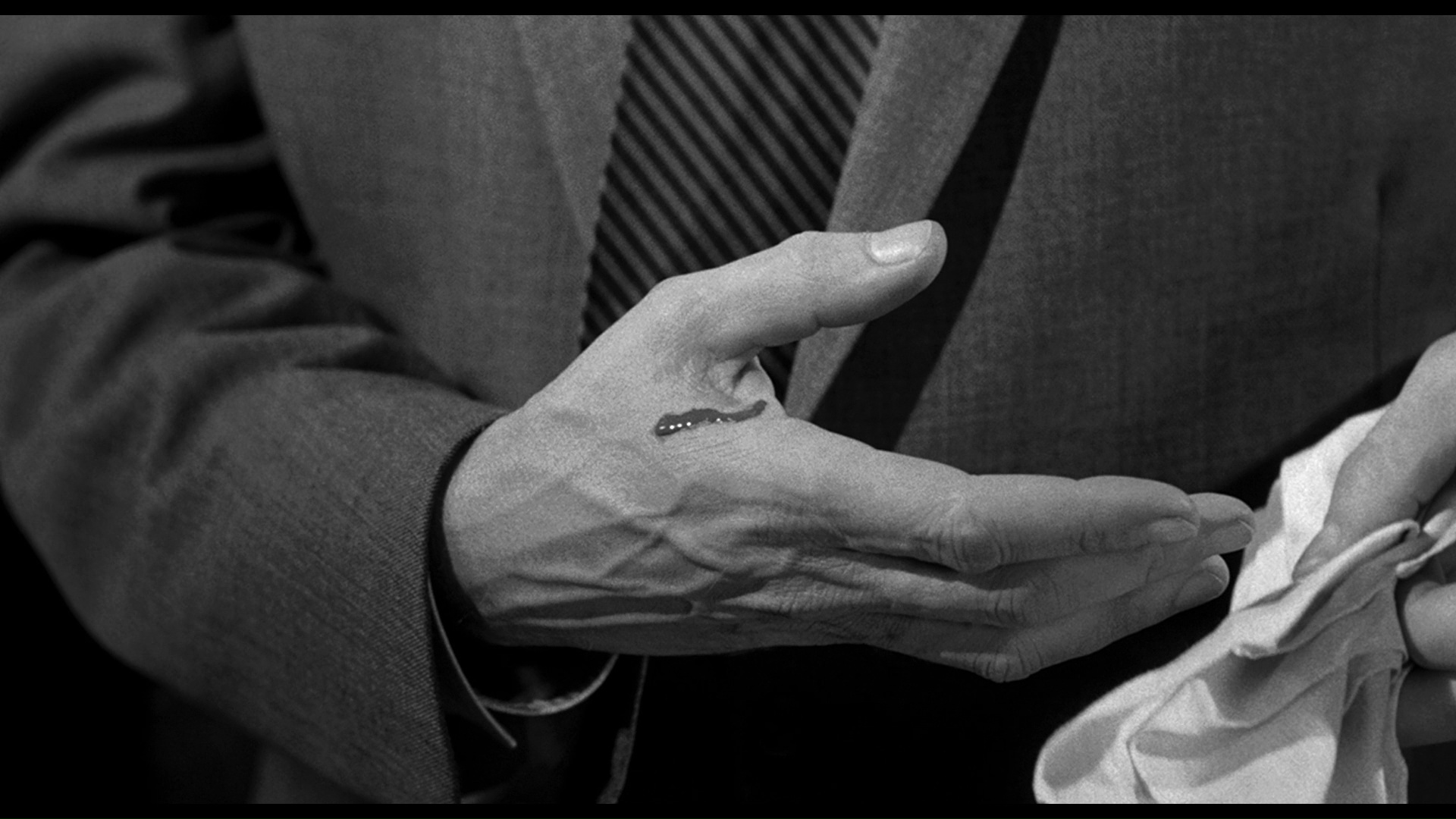 urges patrons to "scream for your lives!" In another gimmick, the black and white image suddenly turns to blood red tinted color for one scare sequence involving a sanguinary bathroom sink and tub, and some theaters even slammed
urges patrons to "scream for your lives!" In another gimmick, the black and white image suddenly turns to blood red tinted color for one scare sequence involving a sanguinary bathroom sink and tub, and some theaters even slammed 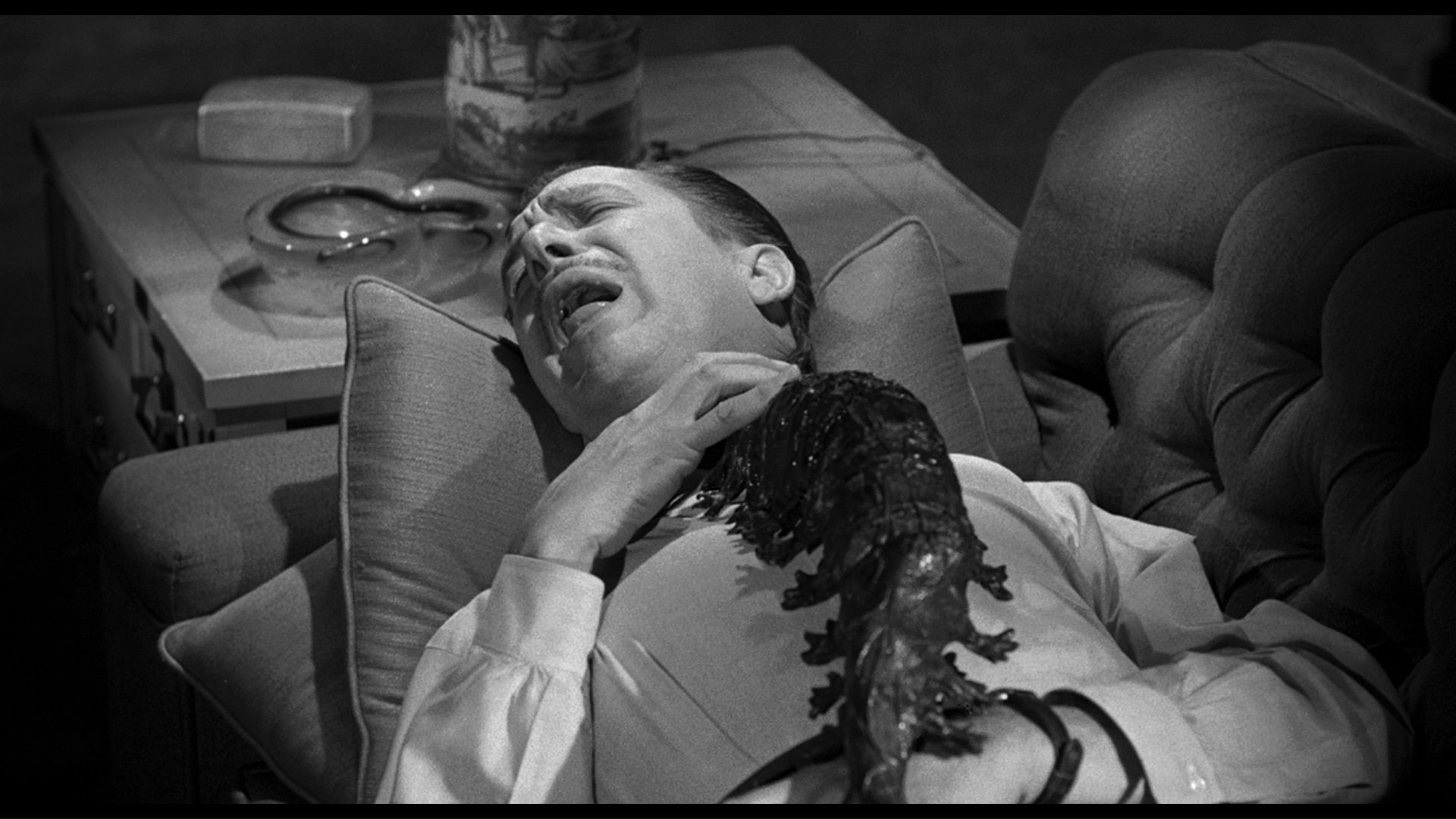 on the house lights when Price informed patrons that someone in the audience had fainted and was being carried out -- duplicated in the actual theater by a planted viewer. While Percepto would be impossible to duplicate in a home theater environment (unless you're a very crafty electrician or manage to set off a bunch of cell phones at once), the other two gimmicks are more or less present and accounted for on its home video editions starting with Sony's 1999 DVD. The bathtub sequence has been very problematic over the years (looking brown and ugly on the earlier laserdisc); it's appropriately red here but very soft thanks to a 16mm source, a problem that plagued all subsequent releases except for the Indicator. The studio has actually uncovered a variation on the "Scream!" sequence amusingly designed for drive-ins. The anamorphic transfer looked great for its time, with Von Dexter's delirious Vertigo-inspired score sounding clear and punchy. Though mono, the opening screams alone should give your sound system a real workout - and for those of you set up for surround, there's one very nice, well timed surprise. The DVD also includes a nifty featurette, "Scream for Your Lives!" (15m40s), with Hickman talking about the making of the film, plus footage of Castle and reminiscences of the film's splashy opening in San Antonio. Also includes the original theatrical trailer, as well as a trailer for the 1990 version of Night of the Living Dead. This film (and the others included in this set) later appeared in Sony's 2009 DVD set, The William Castle Film Collection, with a slew of extras that will be detailed below for their respective titles as they're all ported over for the Indicator box. A standalone U.S. Blu-ray is also available from Scream Factory (not available for comparison as of this writing) with extras including an audio commentary by Steve Haberman, an "I Survived the Tingler" video interview (4m8s) with Pamela Lincoln about her early gig screaming her head off for the film, an "Unleashing Percepto" featurette (2m57s) with Columbia publicist Barry Lorie, the previous "Scream for Your Lives!" featurette and drive-in option, lobby recording, trailer, and still gallery. The first Blu-ray out of the gate actually came earlier from Germany, but it's extremely expensive and far less robust than the other other options.
on the house lights when Price informed patrons that someone in the audience had fainted and was being carried out -- duplicated in the actual theater by a planted viewer. While Percepto would be impossible to duplicate in a home theater environment (unless you're a very crafty electrician or manage to set off a bunch of cell phones at once), the other two gimmicks are more or less present and accounted for on its home video editions starting with Sony's 1999 DVD. The bathtub sequence has been very problematic over the years (looking brown and ugly on the earlier laserdisc); it's appropriately red here but very soft thanks to a 16mm source, a problem that plagued all subsequent releases except for the Indicator. The studio has actually uncovered a variation on the "Scream!" sequence amusingly designed for drive-ins. The anamorphic transfer looked great for its time, with Von Dexter's delirious Vertigo-inspired score sounding clear and punchy. Though mono, the opening screams alone should give your sound system a real workout - and for those of you set up for surround, there's one very nice, well timed surprise. The DVD also includes a nifty featurette, "Scream for Your Lives!" (15m40s), with Hickman talking about the making of the film, plus footage of Castle and reminiscences of the film's splashy opening in San Antonio. Also includes the original theatrical trailer, as well as a trailer for the 1990 version of Night of the Living Dead. This film (and the others included in this set) later appeared in Sony's 2009 DVD set, The William Castle Film Collection, with a slew of extras that will be detailed below for their respective titles as they're all ported over for the Indicator box. A standalone U.S. Blu-ray is also available from Scream Factory (not available for comparison as of this writing) with extras including an audio commentary by Steve Haberman, an "I Survived the Tingler" video interview (4m8s) with Pamela Lincoln about her early gig screaming her head off for the film, an "Unleashing Percepto" featurette (2m57s) with Columbia publicist Barry Lorie, the previous "Scream for Your Lives!" featurette and drive-in option, lobby recording, trailer, and still gallery. The first Blu-ray out of the gate actually came earlier from Germany, but it's extremely expensive and far less robust than the other other options. 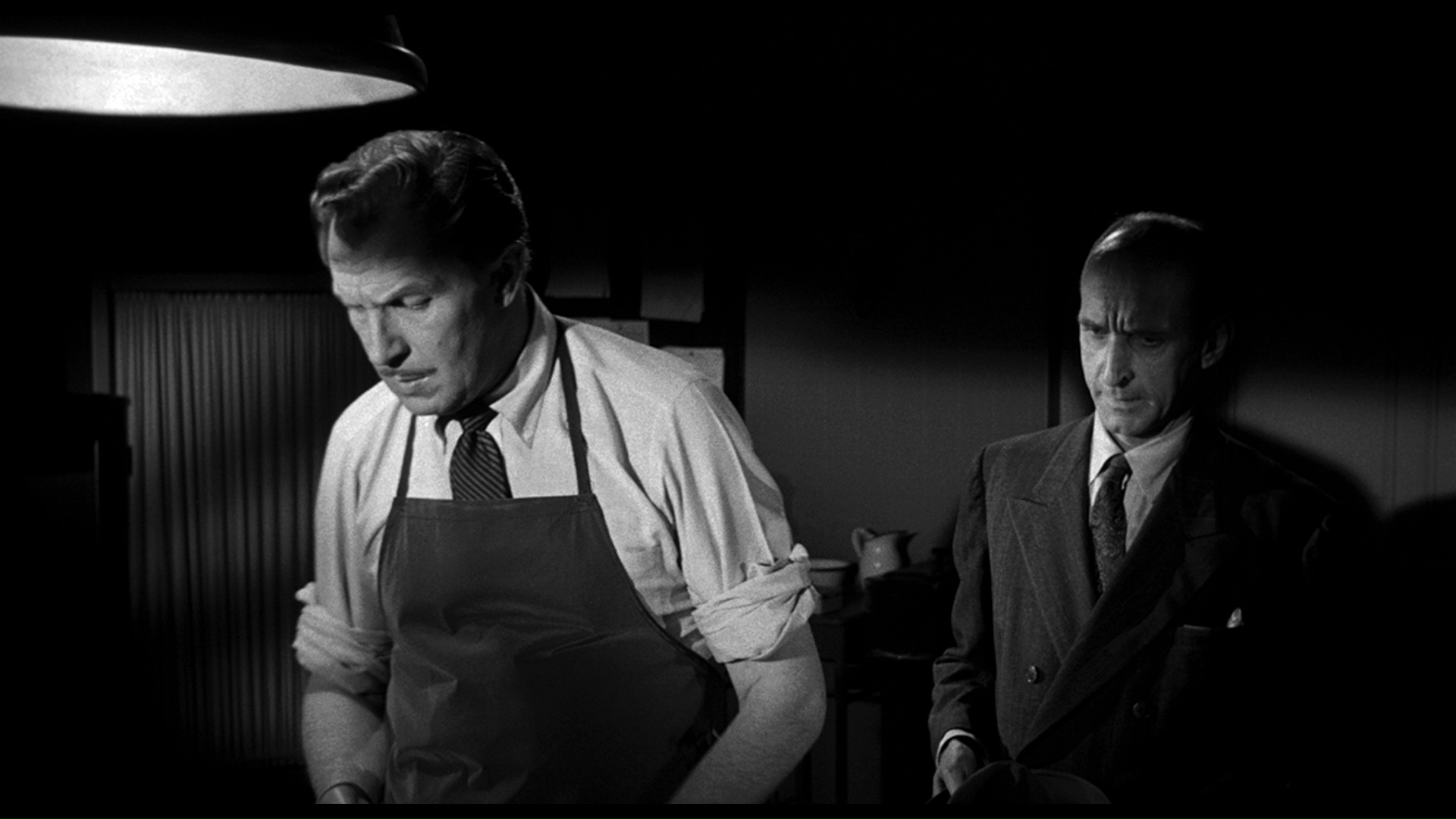
 The Indicator Blu-ray lives up to the high standards of the company's prior Sony releases with the feature itself given a generous and immaculate encoding job that keeps the fine grain intact throughout and the blacks suitably dark and rich. As with the other films in the set, it has an English LPCM mono track with optional English SDH subtitles. Bonus audio options include the stereo "Scream" sequence and the alternate drive-in highlights option. You also get a major bonus for horror soundtrack fans courtesy of an isolated music and effects track, the first time that wild score has ever been separated in any form at all. Carried over from past releases are "Scream for Your Lives!" and the theatrical trailer (plus a Trailers from Hell version hosted by Joe Dante), while a new audio commentary with Jonathan Rigby and Kevin Lyons joyfully dissects all things Castle including the film's commentary on film history and bygone eras, the history-making LSD scene (including a funny observation about that ridiculous book cover), and the avalanche of clever touches like stashing the tingler in a film can. In "Imaginary Biology" (16m19s), author Kim Newman makes a case for appreciating the film as a "bizarro masterpiece" even divorced from the experience of watching it with Percepto. The "I Survived the Tingler" and "Unleashing Percepto" featurettes appear here as well along with an incredible theater lobby spot (actually a full-on song written to promote the film, with Price narration), plus two separate galleries for promotional materials (33 images) and a great Percepto instruction manual so you can build your very own right at home.
The Indicator Blu-ray lives up to the high standards of the company's prior Sony releases with the feature itself given a generous and immaculate encoding job that keeps the fine grain intact throughout and the blacks suitably dark and rich. As with the other films in the set, it has an English LPCM mono track with optional English SDH subtitles. Bonus audio options include the stereo "Scream" sequence and the alternate drive-in highlights option. You also get a major bonus for horror soundtrack fans courtesy of an isolated music and effects track, the first time that wild score has ever been separated in any form at all. Carried over from past releases are "Scream for Your Lives!" and the theatrical trailer (plus a Trailers from Hell version hosted by Joe Dante), while a new audio commentary with Jonathan Rigby and Kevin Lyons joyfully dissects all things Castle including the film's commentary on film history and bygone eras, the history-making LSD scene (including a funny observation about that ridiculous book cover), and the avalanche of clever touches like stashing the tingler in a film can. In "Imaginary Biology" (16m19s), author Kim Newman makes a case for appreciating the film as a "bizarro masterpiece" even divorced from the experience of watching it with Percepto. The "I Survived the Tingler" and "Unleashing Percepto" featurettes appear here as well along with an incredible theater lobby spot (actually a full-on song written to promote the film, with Price narration), plus two separate galleries for promotional materials (33 images) and a great Percepto instruction manual so you can build your very own right at home. 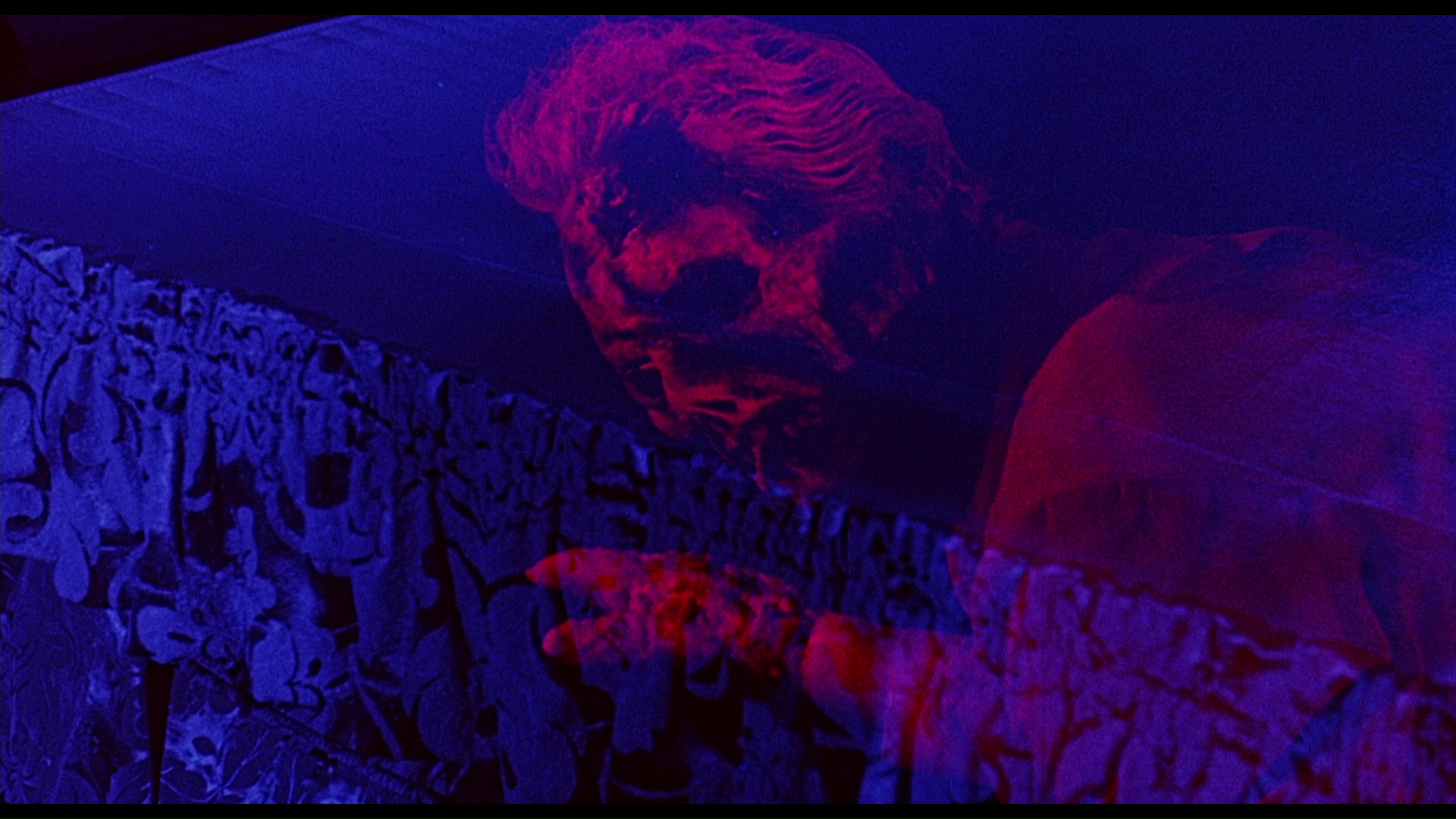 After Castle and writer Robb White had devised the go for broke, surrealist spectacle of The Tingler, they retreated
After Castle and writer Robb White had devised the go for broke, surrealist spectacle of The Tingler, they retreated 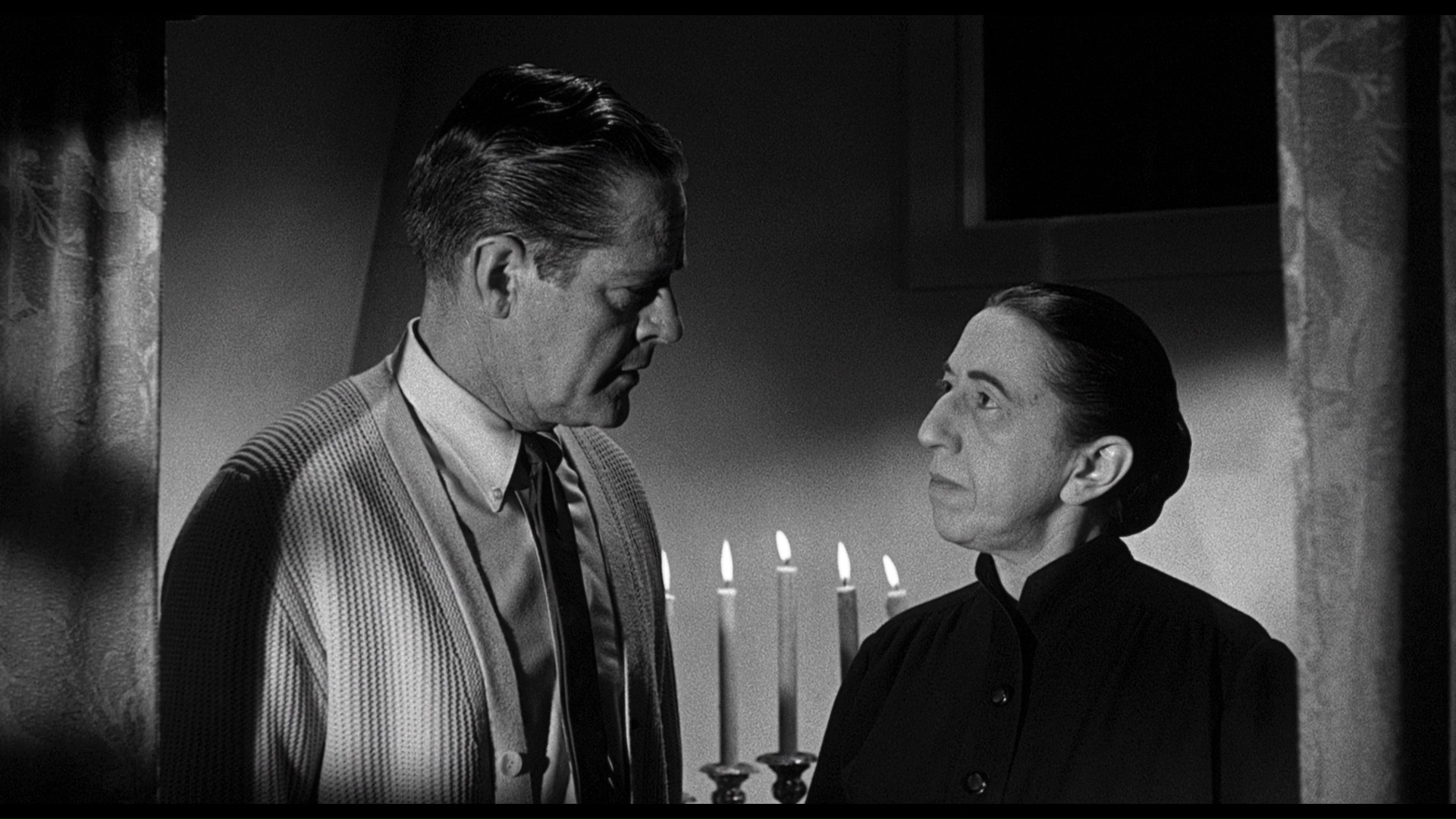 somewhat with a more linear, restrained haunted house yarn called 13 Ghosts -- but this being a Castle film, it's still far more outlandish than what his contemporaries were cranking out at the time.
Strapped for cash, the Zorba family headed by father Cyrus (Woods) and mother Hilda (DeCamp) prepares for eviction by celebrating the birthday of their youngest son, Buck (Herbert), who wishes for a real house with furniture. That wish is answered sooner than expected when a telegram arrives announcing their inheritance of a nearby Los Angeles estate owned by Cyrus' eccentric uncle, Plato Zorba, who was believed dead ten years earlier. The dead man's attorney and friend, Ben (Route 66's Martin Milner), explains that the furnished house comes with a spooky housekeeper (Hamilton) and a collection of ghosts amassed by Zorba during his trips around the world. The older daughter, Medea (Morrow), finds her flirting with Ben interrupted when a Ouija board experiment points her out as the ghosts' next victim, and Buck develops a rapport with the specters who can only be viewed with a special experimental viewer. Things get even more complicated when the Zobras learn that a large cache of money may be secreted somewhere in the house... and they must try to find the location of the treasure before the ghosts decide once and for all to get rid of the new residents.
somewhat with a more linear, restrained haunted house yarn called 13 Ghosts -- but this being a Castle film, it's still far more outlandish than what his contemporaries were cranking out at the time.
Strapped for cash, the Zorba family headed by father Cyrus (Woods) and mother Hilda (DeCamp) prepares for eviction by celebrating the birthday of their youngest son, Buck (Herbert), who wishes for a real house with furniture. That wish is answered sooner than expected when a telegram arrives announcing their inheritance of a nearby Los Angeles estate owned by Cyrus' eccentric uncle, Plato Zorba, who was believed dead ten years earlier. The dead man's attorney and friend, Ben (Route 66's Martin Milner), explains that the furnished house comes with a spooky housekeeper (Hamilton) and a collection of ghosts amassed by Zorba during his trips around the world. The older daughter, Medea (Morrow), finds her flirting with Ben interrupted when a Ouija board experiment points her out as the ghosts' next victim, and Buck develops a rapport with the specters who can only be viewed with a special experimental viewer. Things get even more complicated when the Zobras learn that a large cache of money may be secreted somewhere in the house... and they must try to find the location of the treasure before the ghosts decide once and for all to get rid of the new residents. by the film's famous promotional gimmick, "Illusion-O." Each ghost appearance (regardless of whether it's seen through the ghost viewer in the film) in the black and white film is tinted blue, with the ghost opticals printed in red. Essentially a simpler variation on 3-D, this process allows the ghosts to be seen clearly when viewed through the red lens on the viewer, while they vanish altogether when seen through the blue one. Without the viewer, the ghosts are barely visible but look
by the film's famous promotional gimmick, "Illusion-O." Each ghost appearance (regardless of whether it's seen through the ghost viewer in the film) in the black and white film is tinted blue, with the ghost opticals printed in red. Essentially a simpler variation on 3-D, this process allows the ghosts to be seen clearly when viewed through the red lens on the viewer, while they vanish altogether when seen through the blue one. Without the viewer, the ghosts are barely visible but look  murky, a condition duplicated when the film was reissued in straight black and white. Though not as dramatic as the House on Haunted Hill method of barreling skeletons out over the audience, it's a nice gesture and represents Castle at his most eager to please. Otherwise the film is a lot of fun, and its less than brilliant acting actually gives the ridiculous proceedings a more offbeat, tongue in cheek sense of flair, right down to the cheeky casting of The Wizard of Oz's Wicked Witch, Hamilton, as the "witch" medium/housekeeper who provides the film with its nifty final wink at the viewer.
murky, a condition duplicated when the film was reissued in straight black and white. Though not as dramatic as the House on Haunted Hill method of barreling skeletons out over the audience, it's a nice gesture and represents Castle at his most eager to please. Otherwise the film is a lot of fun, and its less than brilliant acting actually gives the ridiculous proceedings a more offbeat, tongue in cheek sense of flair, right down to the cheeky casting of The Wizard of Oz's Wicked Witch, Hamilton, as the "witch" medium/housekeeper who provides the film with its nifty final wink at the viewer.
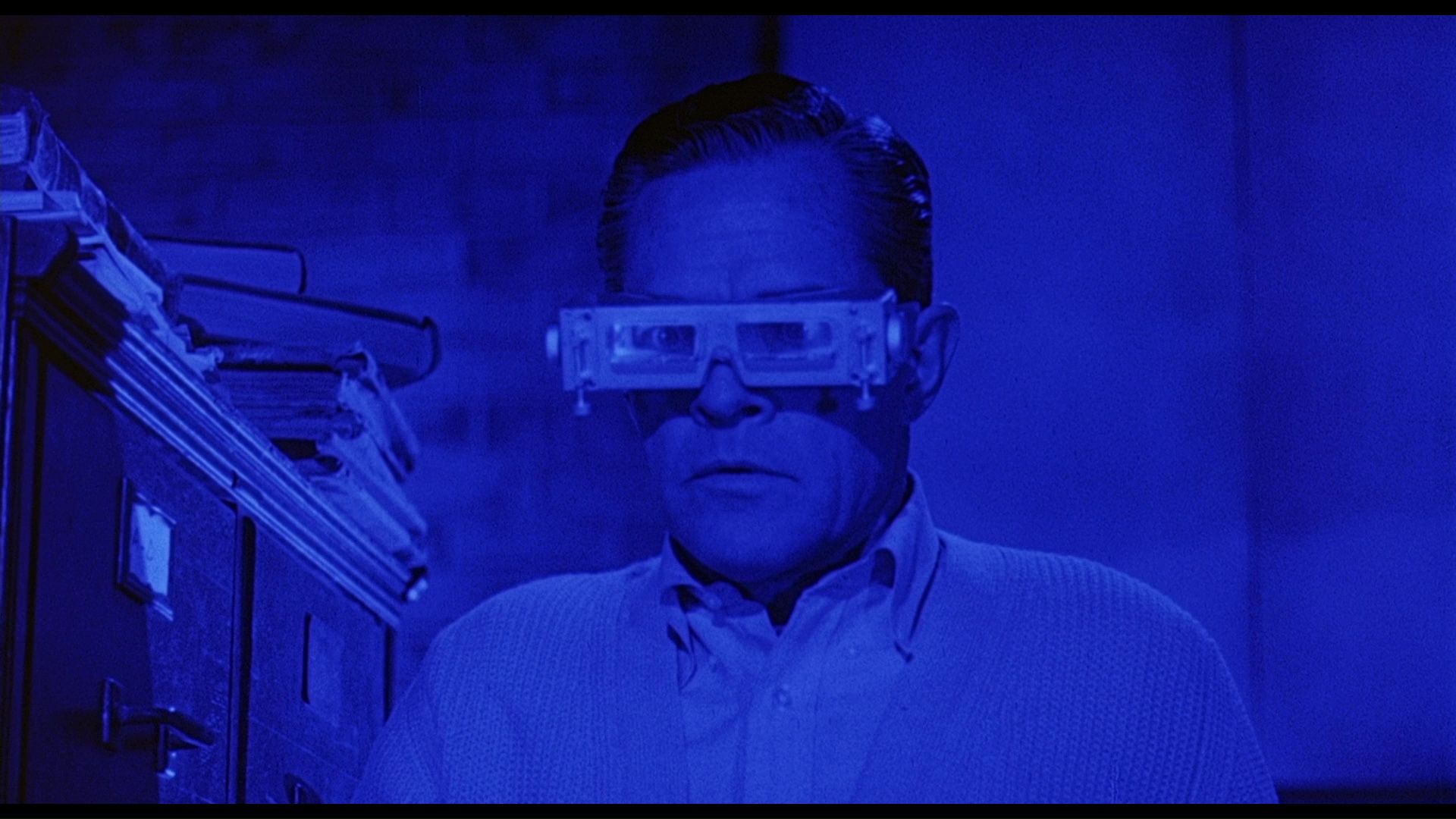 Michael Schlesinger, Don Glut and Bob Burns and explaining how Castle's gimmick was executed in theaters and scared the daylights out of young popcorn munchers.
Michael Schlesinger, Don Glut and Bob Burns and explaining how Castle's gimmick was executed in theaters and scared the daylights out of young popcorn munchers. 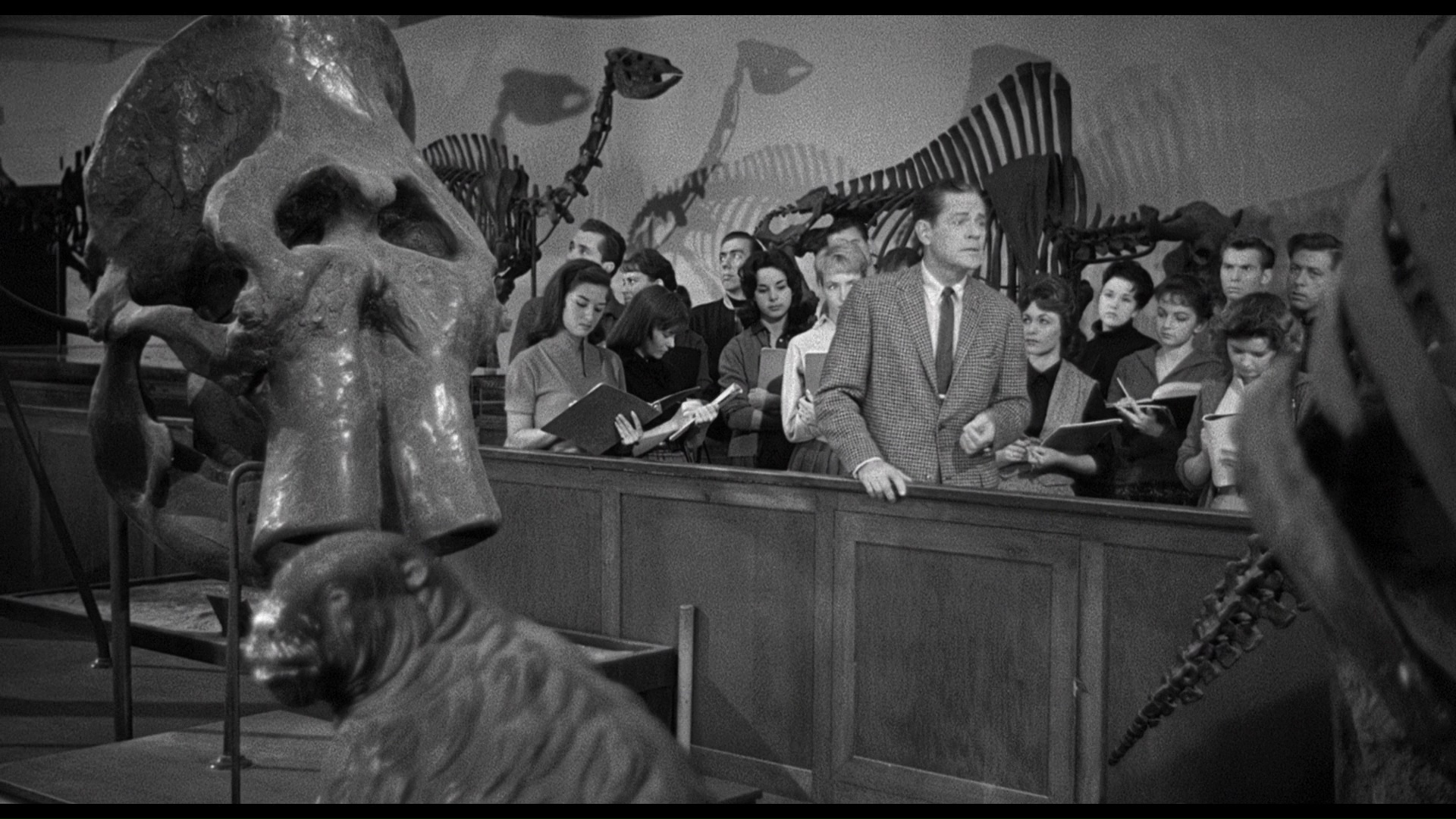
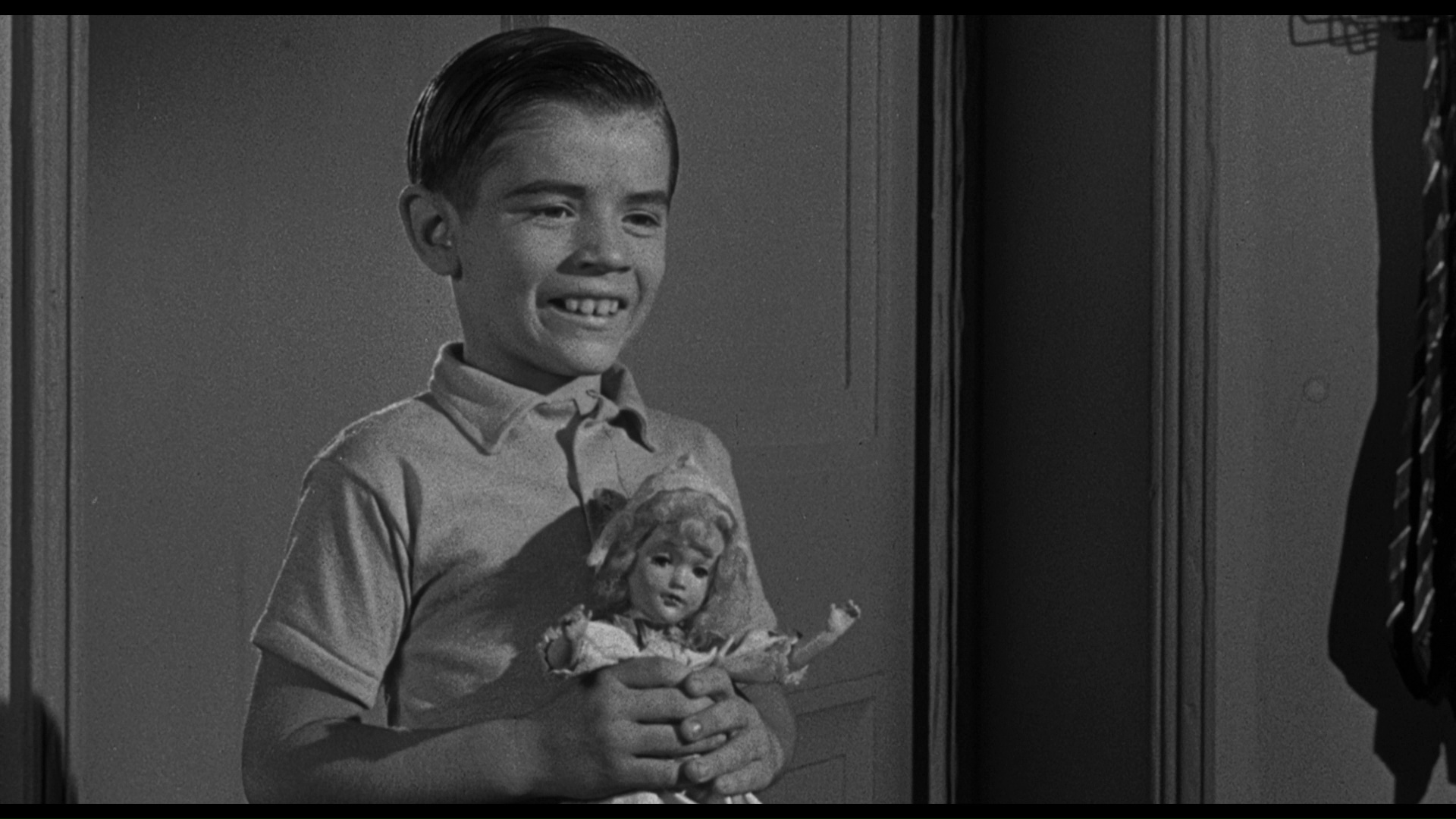 With Castle drawing in huge audiences by now, his ballyhoo was bound to grab the attention of the screen's
With Castle drawing in huge audiences by now, his ballyhoo was bound to grab the attention of the screen's 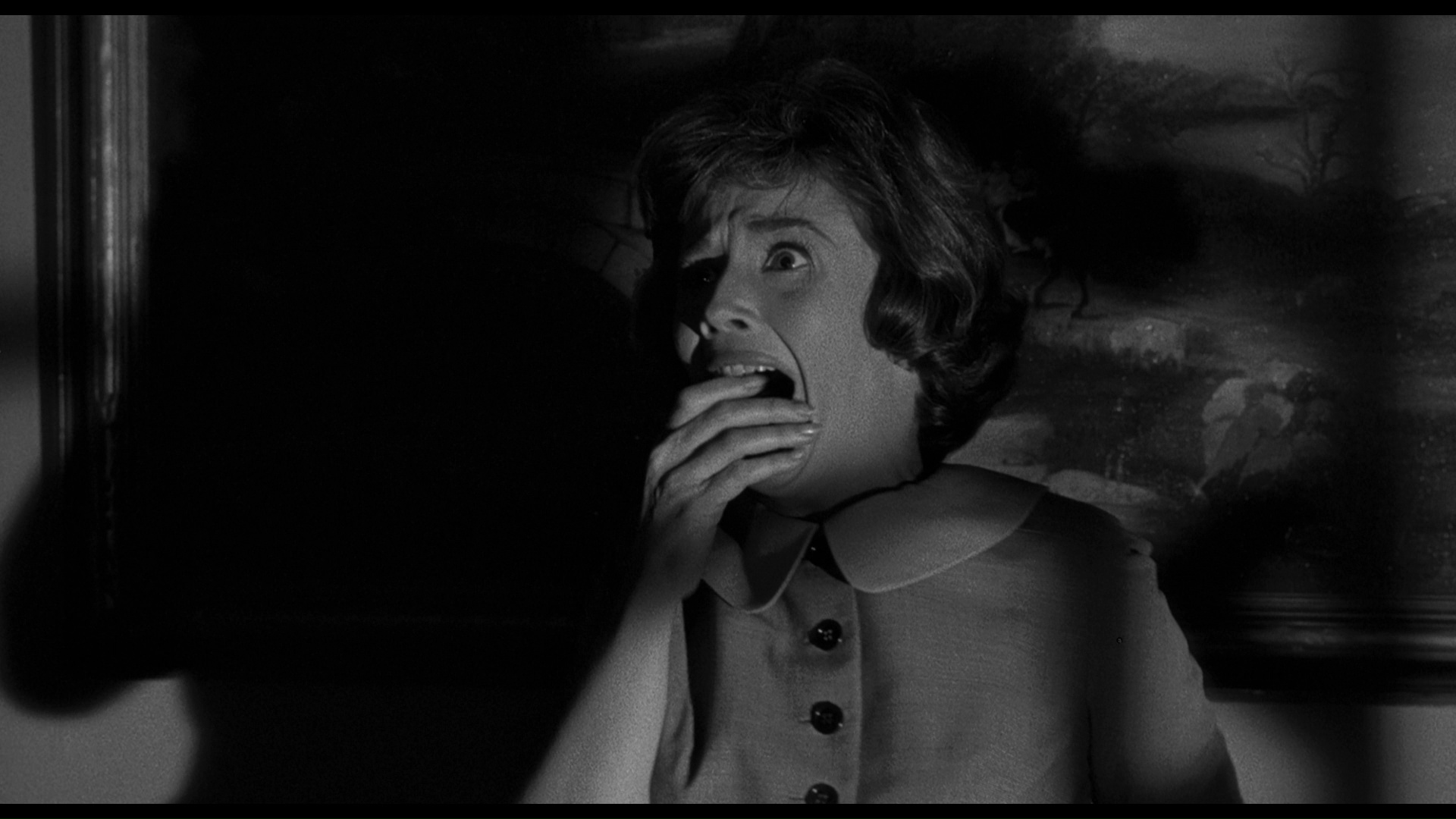 premiere master of suspense, Alfred Hitchcock. Not to be outdone, Hitch pulled out all the stops in 1960 for his first 100%, full-fledged horror film, Psycho, which was accompanied by a barrage of gimmicks including refusal to allow ticket holders in after the start of the film, prohibition from revealing the ending, and a host of promotional come-ons including standees and pitches to passersby featuring Hitchcock himself. Castle took up the challenge and came up with his own spin on the idea with his own baroque psycho shocker, Homicidal, which was promoted with a "Fright Break" allowing people too terrified to finish the film a chance to leave before the climax and get their money back. When that idea left a loophole open for people to just catch the ending first by coming in early, sticking around and getting a refund, he then instituted a "Coward's Corner" at the end of a yellow path in the theater where the poor saps would be ridiculed by their friends. Luckily the film itself lived up to the hype with a shocking early knife murder, a memorable grotesque sequence involving a staircase and a wheelchair, and a twist revelation that still stands out as the wildest of all the Psycho imitators.
premiere master of suspense, Alfred Hitchcock. Not to be outdone, Hitch pulled out all the stops in 1960 for his first 100%, full-fledged horror film, Psycho, which was accompanied by a barrage of gimmicks including refusal to allow ticket holders in after the start of the film, prohibition from revealing the ending, and a host of promotional come-ons including standees and pitches to passersby featuring Hitchcock himself. Castle took up the challenge and came up with his own spin on the idea with his own baroque psycho shocker, Homicidal, which was promoted with a "Fright Break" allowing people too terrified to finish the film a chance to leave before the climax and get their money back. When that idea left a loophole open for people to just catch the ending first by coming in early, sticking around and getting a refund, he then instituted a "Coward's Corner" at the end of a yellow path in the theater where the poor saps would be ridiculed by their friends. Luckily the film itself lived up to the hype with a shocking early knife murder, a memorable grotesque sequence involving a staircase and a wheelchair, and a twist revelation that still stands out as the wildest of all the Psycho imitators. 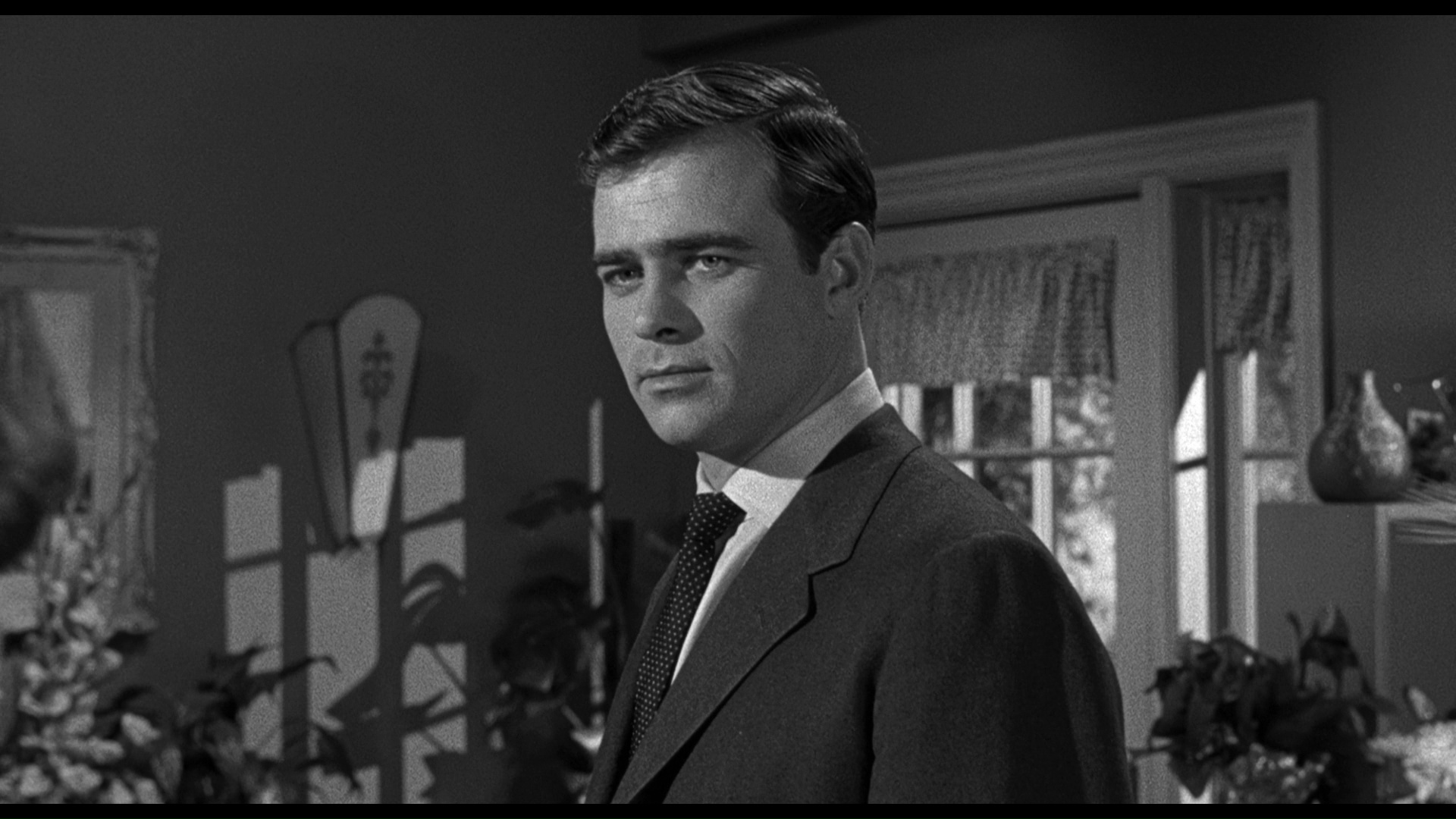 to the justice of the peace's home turns nasty when she brutally stabs the
to the justice of the peace's home turns nasty when she brutally stabs the 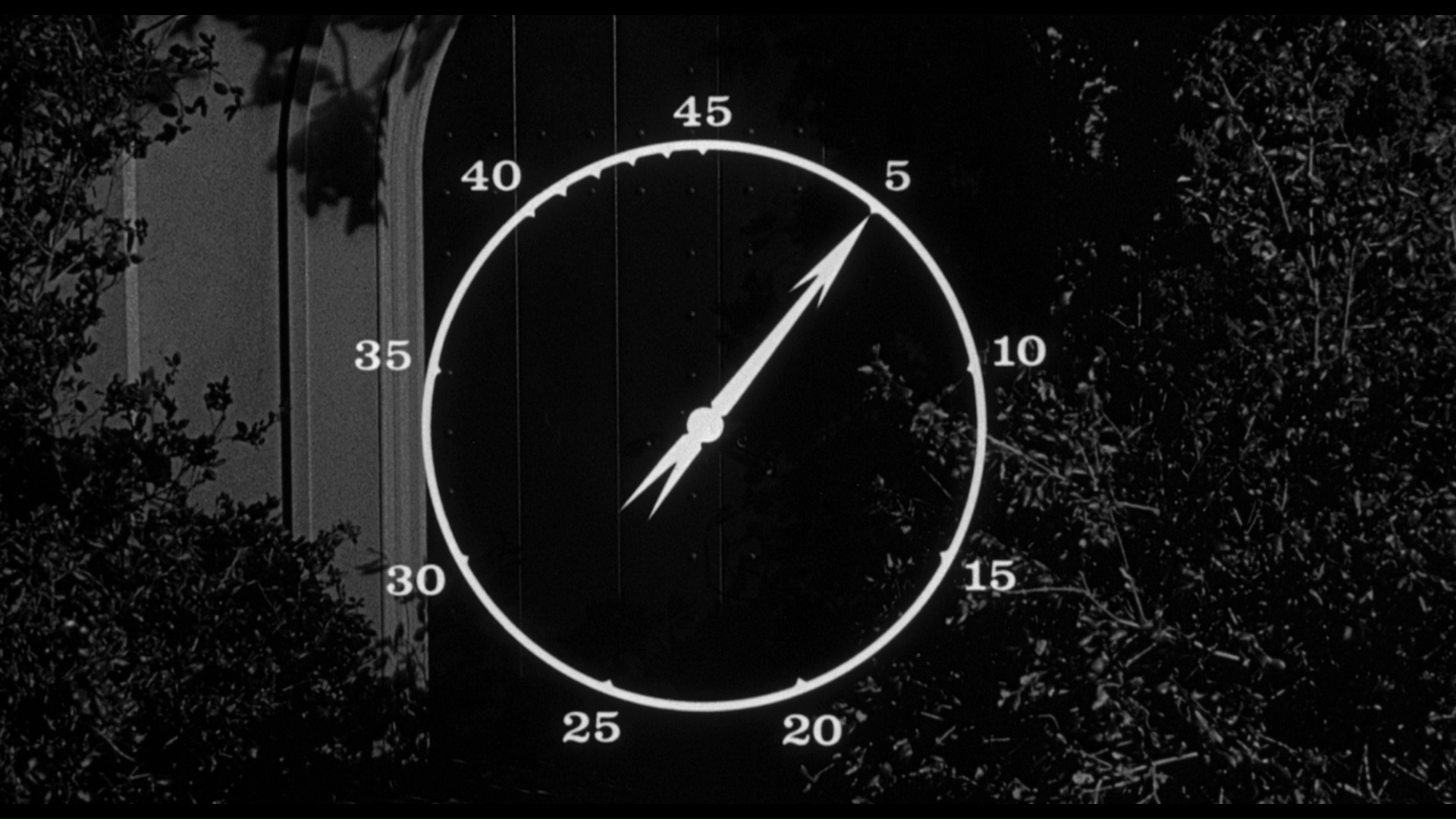 officiant to death in the middle of the ceremony. All clues point to a family in town, Miriam (Breslin) and her brother Warren, who are set to inherit a large sum from their dead father's estate. However, the knife-happy Emily is actually taking care of the family's mute, wheelchair-bound former nanny, Helga (Leontovich) and tends to fly into random threatening rages. Miriam and her fiancé, Karl (The Crimson Kimono's Corbett), grow to suspect that's something amiss and soon uncover a shocking family secret.
officiant to death in the middle of the ceremony. All clues point to a family in town, Miriam (Breslin) and her brother Warren, who are set to inherit a large sum from their dead father's estate. However, the knife-happy Emily is actually taking care of the family's mute, wheelchair-bound former nanny, Helga (Leontovich) and tends to fly into random threatening rages. Miriam and her fiancé, Karl (The Crimson Kimono's Corbett), grow to suspect that's something amiss and soon uncover a shocking family secret. 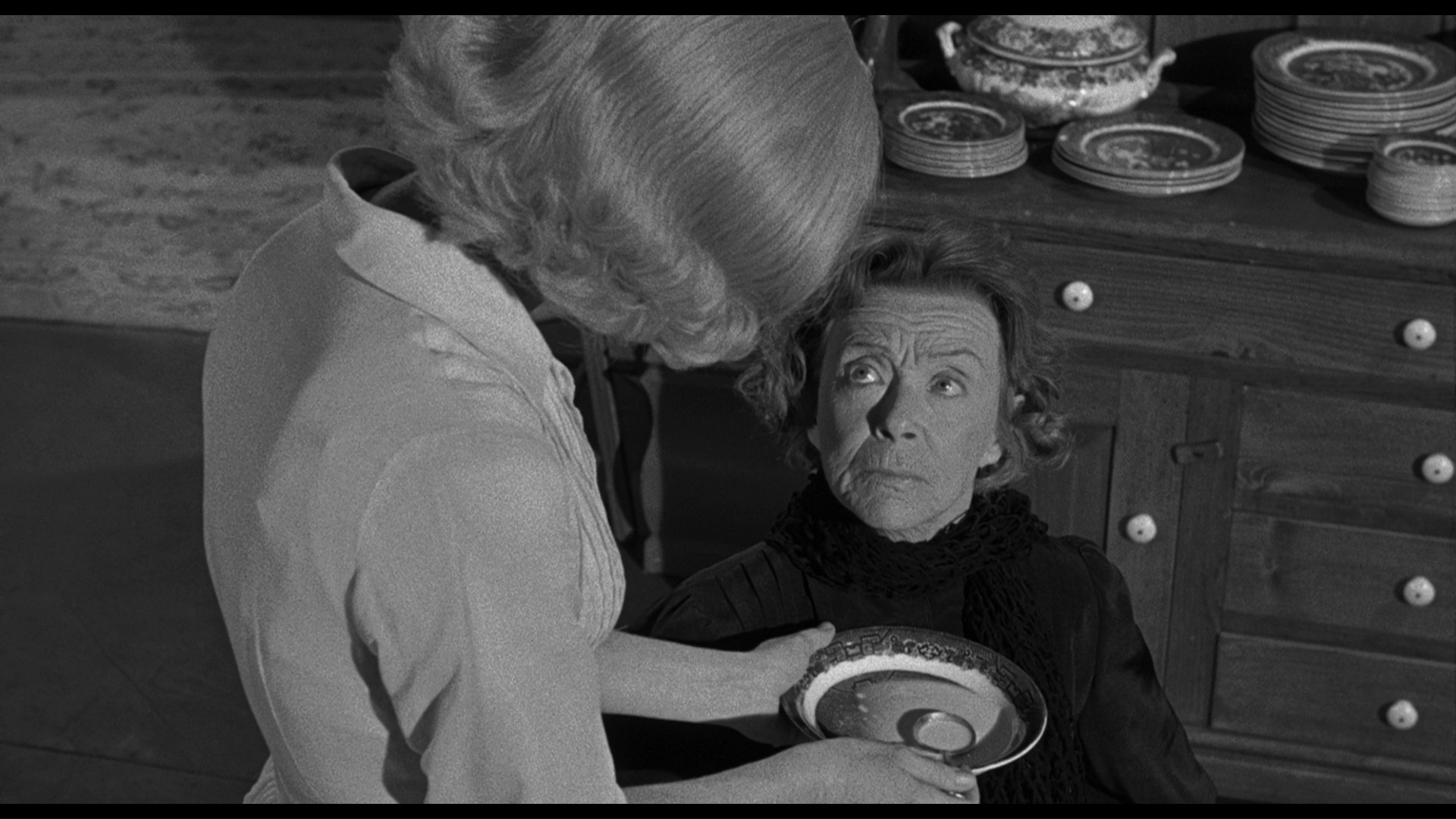 release is the best presentation to date again,
release is the best presentation to date again, 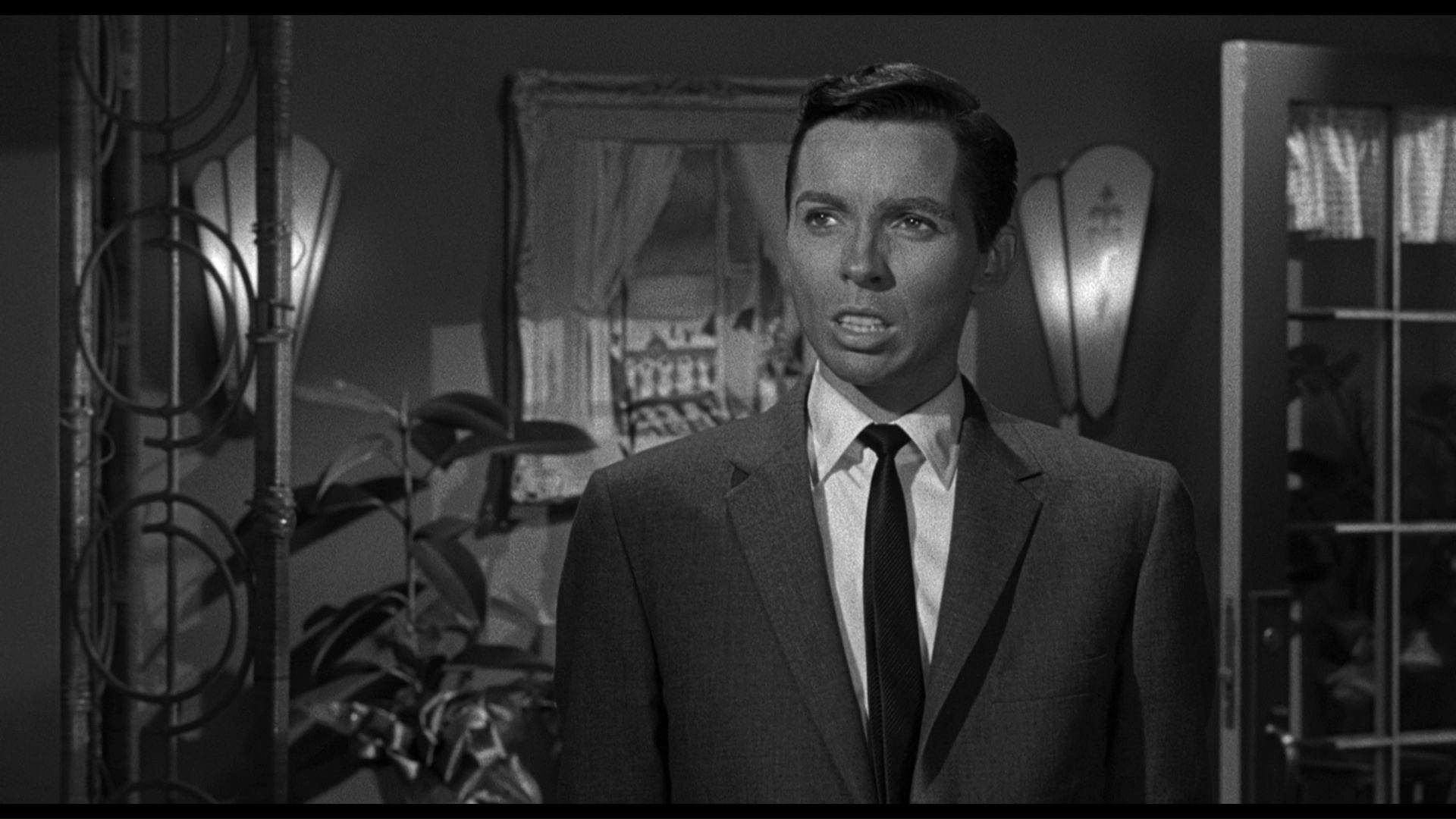 with the frequent night scenes and fine but palpable film grain handled very well by a skillful encoding job. The presentation of the original 1.85:1 framing helps things as well. Ported over from the older DVD releases is "Psychette: William Castle and Homicidal" (7m42s), an overview of the film's creation and promotion as explained by participants like Don Glut, Fred Olen Ray, Bob Burns, and David Del Valle. A new audio commentary by Lee Gambin offers a giddy, whirlwind tour through psychosexual thrillers, gender bender cinema, and a flurry of horror film titles as well as an appreciation for Castle's sense of the theatrical. The isolated music and effects track is again a welcome bonus, here showcasing the work of composer Hugo Friedhofer whose bizarre credits range from The Best Years of Our Lives to Paul Bartel's Private Parts. A video introduction by Stephen Laws (7m56s) is a handy appraisal of the film as well, even pointing out its unique connection to the original pilot of The Munsters. A promotional shot about a Youngstown, Ohio test engagement (5m2s) is a real treat, too, with footage of Castle welcoming the crowd, handing out tickets, and polling the audience afterwards. In "Ballyhoo!" (3m51s), Bob Thomas pulls out a 1960 interview he conducted about the gimmick touted as "the best in the history of the theater." Also included are complete, outrageous theatrical trailer (much better than the quick little spot seen on past releases) and a gallery of 41 stills and posters as well as a "Coward's Corner Kit."
with the frequent night scenes and fine but palpable film grain handled very well by a skillful encoding job. The presentation of the original 1.85:1 framing helps things as well. Ported over from the older DVD releases is "Psychette: William Castle and Homicidal" (7m42s), an overview of the film's creation and promotion as explained by participants like Don Glut, Fred Olen Ray, Bob Burns, and David Del Valle. A new audio commentary by Lee Gambin offers a giddy, whirlwind tour through psychosexual thrillers, gender bender cinema, and a flurry of horror film titles as well as an appreciation for Castle's sense of the theatrical. The isolated music and effects track is again a welcome bonus, here showcasing the work of composer Hugo Friedhofer whose bizarre credits range from The Best Years of Our Lives to Paul Bartel's Private Parts. A video introduction by Stephen Laws (7m56s) is a handy appraisal of the film as well, even pointing out its unique connection to the original pilot of The Munsters. A promotional shot about a Youngstown, Ohio test engagement (5m2s) is a real treat, too, with footage of Castle welcoming the crowd, handing out tickets, and polling the audience afterwards. In "Ballyhoo!" (3m51s), Bob Thomas pulls out a 1960 interview he conducted about the gimmick touted as "the best in the history of the theater." Also included are complete, outrageous theatrical trailer (much better than the quick little spot seen on past releases) and a gallery of 41 stills and posters as well as a "Coward's Corner Kit."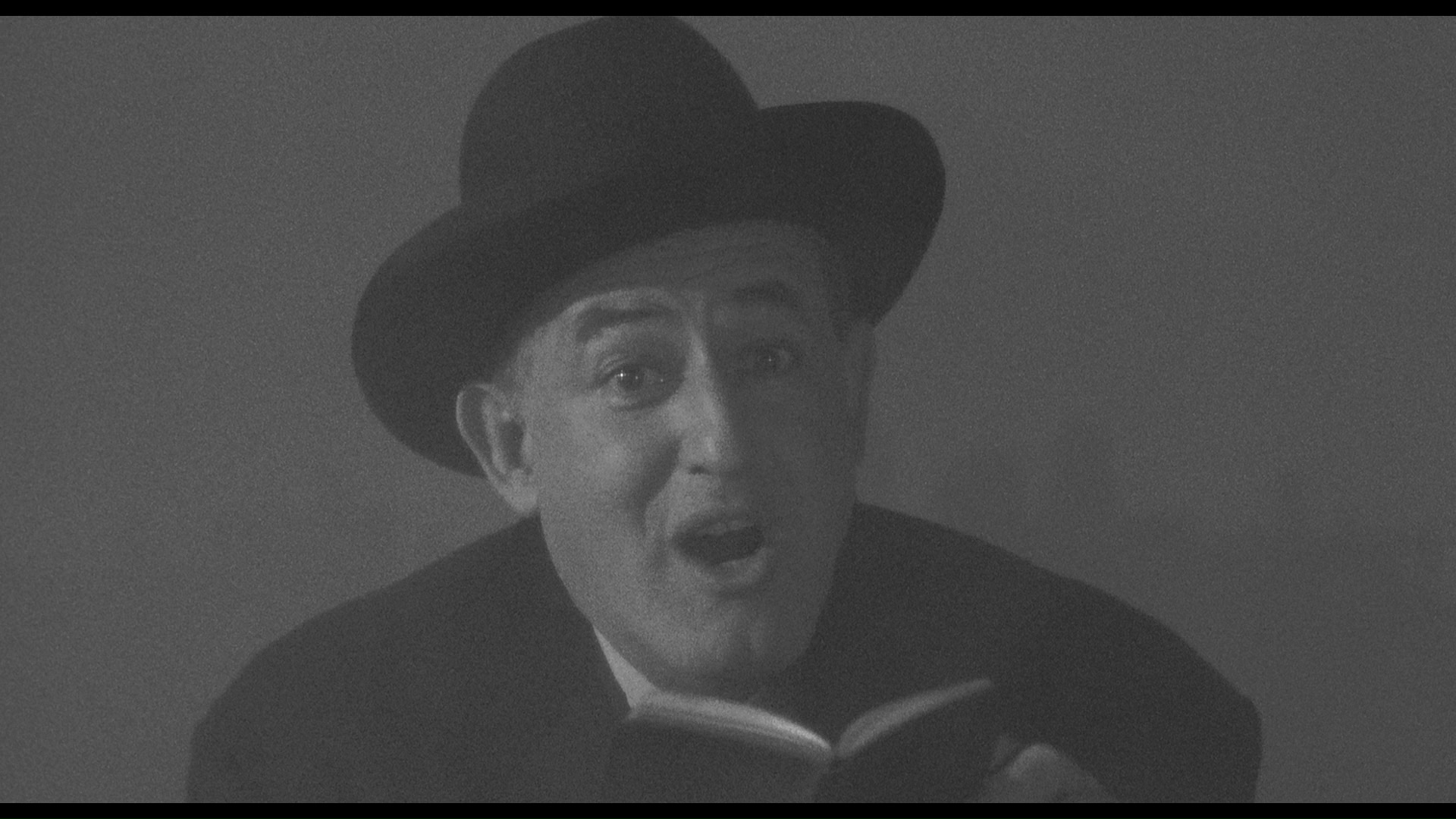 After his outrageous modern-day shockers, it only seemed natural for Castle to make a Gothic period yarn in the Hammer vein.
After his outrageous modern-day shockers, it only seemed natural for Castle to make a Gothic period yarn in the Hammer vein. 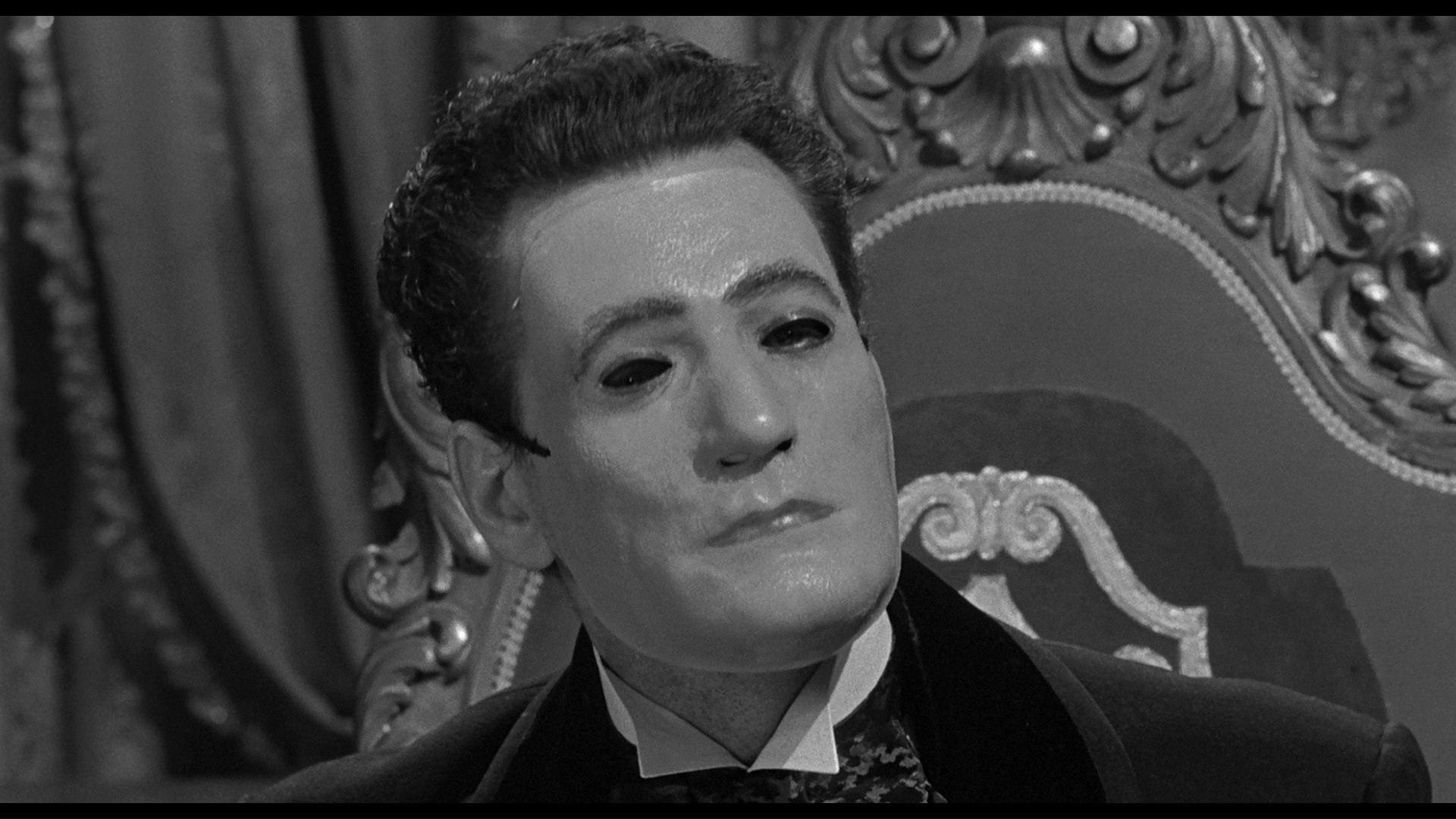 Relatively speaking, Mr. Sardonicus is one of his more restrained works, taking its time to spin out a complex storyline with intricate characters. Of course, Castle fans should have no fear as he also makes time for bloodsucking leeches, grave robbing, disfigurement, revenge, and other nastiness.
Relatively speaking, Mr. Sardonicus is one of his more restrained works, taking its time to spin out a complex storyline with intricate characters. Of course, Castle fans should have no fear as he also makes time for bloodsucking leeches, grave robbing, disfigurement, revenge, and other nastiness. 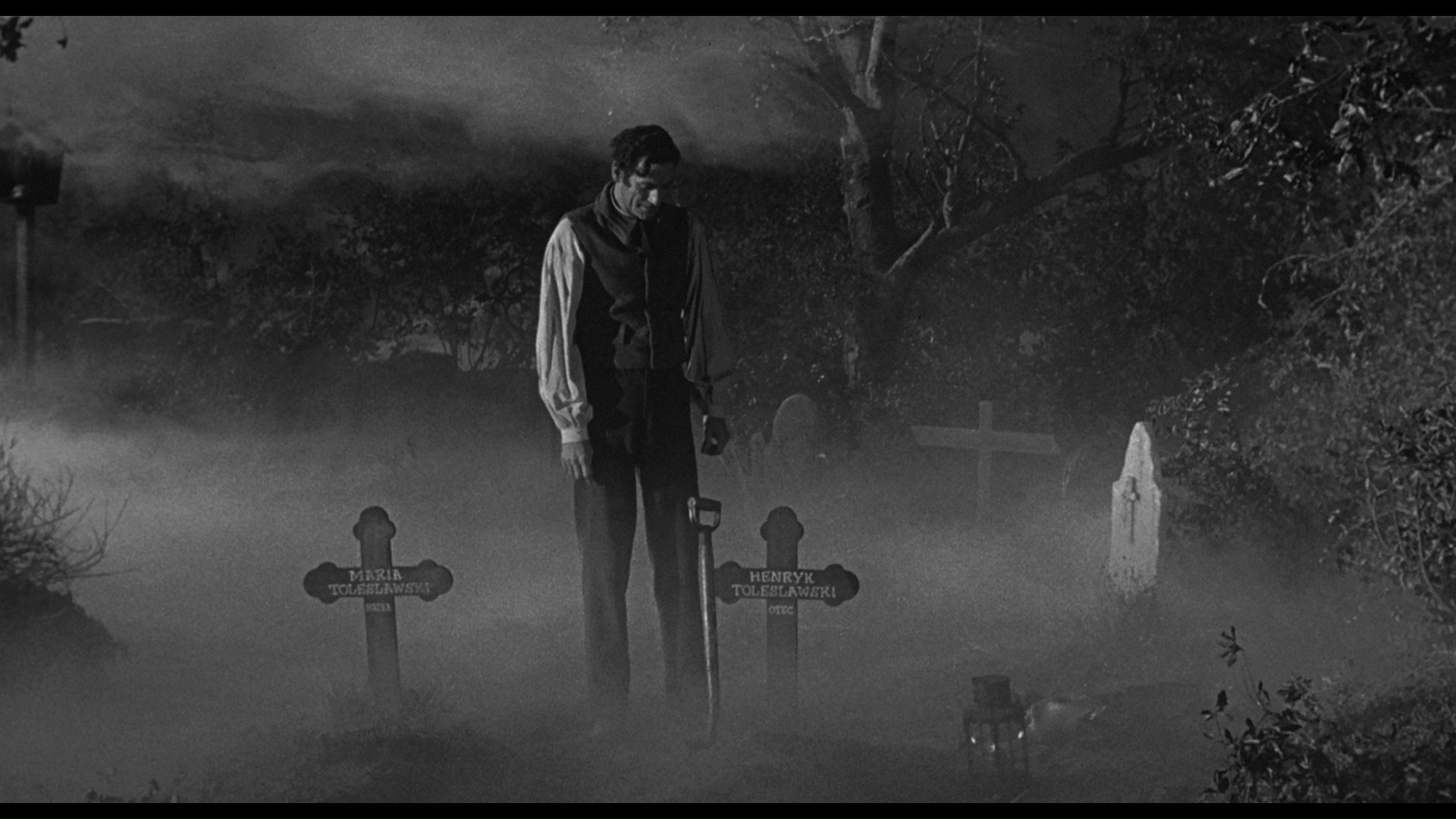 father's decayed face sent Sardonicus into a state of grotesque facial paralysis, a condition which has begun to infect his soul as well...
father's decayed face sent Sardonicus into a state of grotesque facial paralysis, a condition which has begun to infect his soul as well... 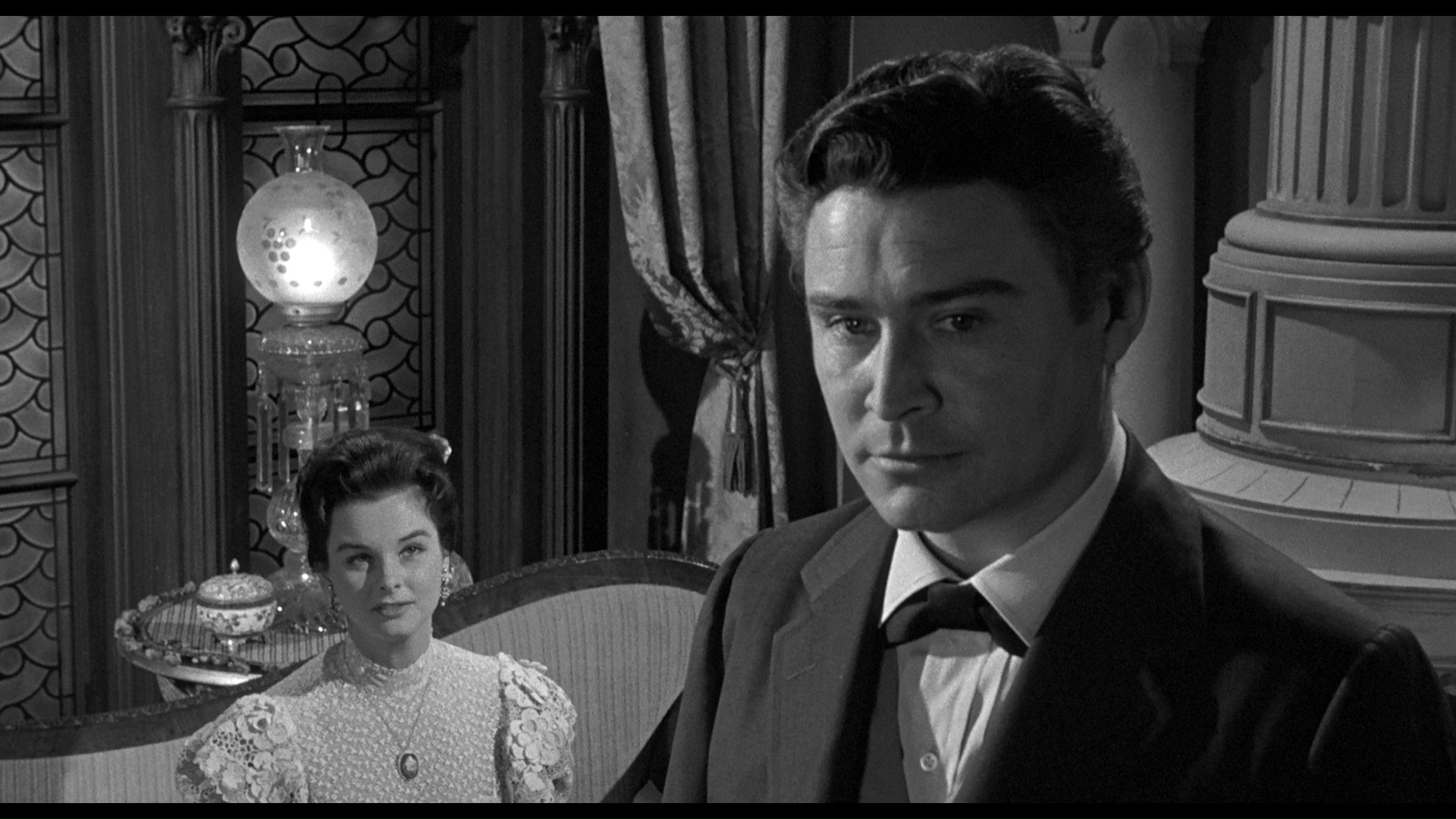 centers around Castle's sole gimmick here, the "Punishment Poll." Castle appears twice: at the beginning of the film to introduce the dictionary meaning of a "ghoul" (only used in the film in a metaphorical sense), and then again before the finale to administer a poll in the audience to determine Sardonicus' fate. All ticket goers were given a card featuring a thumbs up or thumbs down option, and after tabulation, the villain (who isn't that evil, really) is given his due. Of course, Castle only attached one real ending to his prints; never underestimate the bloodlust of the general public. (And can anyone with lipreading abilities decipher what Castle was originally saying before he clumsily relooped his line, "And I hope your nightmares are nice ones"?).
centers around Castle's sole gimmick here, the "Punishment Poll." Castle appears twice: at the beginning of the film to introduce the dictionary meaning of a "ghoul" (only used in the film in a metaphorical sense), and then again before the finale to administer a poll in the audience to determine Sardonicus' fate. All ticket goers were given a card featuring a thumbs up or thumbs down option, and after tabulation, the villain (who isn't that evil, really) is given his due. Of course, Castle only attached one real ending to his prints; never underestimate the bloodlust of the general public. (And can anyone with lipreading abilities decipher what Castle was originally saying before he clumsily relooped his line, "And I hope your nightmares are nice ones"?).  Though Mr. Sardonicus popped up on television occasionally over the years, it remained curiously unavailable on home video for decades until Sony (or Columbia at the time) released a ragged-looking DVD in 2002. Inexplicably, the music on that release goes several seconds out of sync during Chapter 15 (immediately before the grave digging), cutting into the previous dialogue sequence and remaining slightly out of whack throughout the reel. Extras include a new historical featurette, "Taking the Punishment Poll" (7m36s), which offers an affectionate scholarly look at Castle's promotional approach to the film, and trailers for this film along with 13 Ghosts. For some reason this went on to become Castle's most frequently issued film on Blu-ray, including two different releases (with lossy audio) from Mill Creek (first in 2013 as a baffling double feature with Brotherhood of Satan, then in 2016 paired up with Homicidal) It also appeared in a 2015 Castle DVD pack from Mill Creek (along with 13 Ghosts, Homicidal, The Old Dark House and 13 Frightened Girls), but the version to go for is in the Indicator box as it features the best encoding of the film by far as well as the strongest audio presentation. Again you get an isolated music and effects track for that fun Von Dexter score, while a new audio commentary features the always
Though Mr. Sardonicus popped up on television occasionally over the years, it remained curiously unavailable on home video for decades until Sony (or Columbia at the time) released a ragged-looking DVD in 2002. Inexplicably, the music on that release goes several seconds out of sync during Chapter 15 (immediately before the grave digging), cutting into the previous dialogue sequence and remaining slightly out of whack throughout the reel. Extras include a new historical featurette, "Taking the Punishment Poll" (7m36s), which offers an affectionate scholarly look at Castle's promotional approach to the film, and trailers for this film along with 13 Ghosts. For some reason this went on to become Castle's most frequently issued film on Blu-ray, including two different releases (with lossy audio) from Mill Creek (first in 2013 as a baffling double feature with Brotherhood of Satan, then in 2016 paired up with Homicidal) It also appeared in a 2015 Castle DVD pack from Mill Creek (along with 13 Ghosts, Homicidal, The Old Dark House and 13 Frightened Girls), but the version to go for is in the Indicator box as it features the best encoding of the film by far as well as the strongest audio presentation. Again you get an isolated music and effects track for that fun Von Dexter score, while a new audio commentary features the always  worthy team of Daughters of Darkness’ Samm Deighan and Kat Ellinger tackling the film's flamboyant Gothic and German Expressionist elements, Castle's merits as an artists in
worthy team of Daughters of Darkness’ Samm Deighan and Kat Ellinger tackling the film's flamboyant Gothic and German Expressionist elements, Castle's merits as an artists in 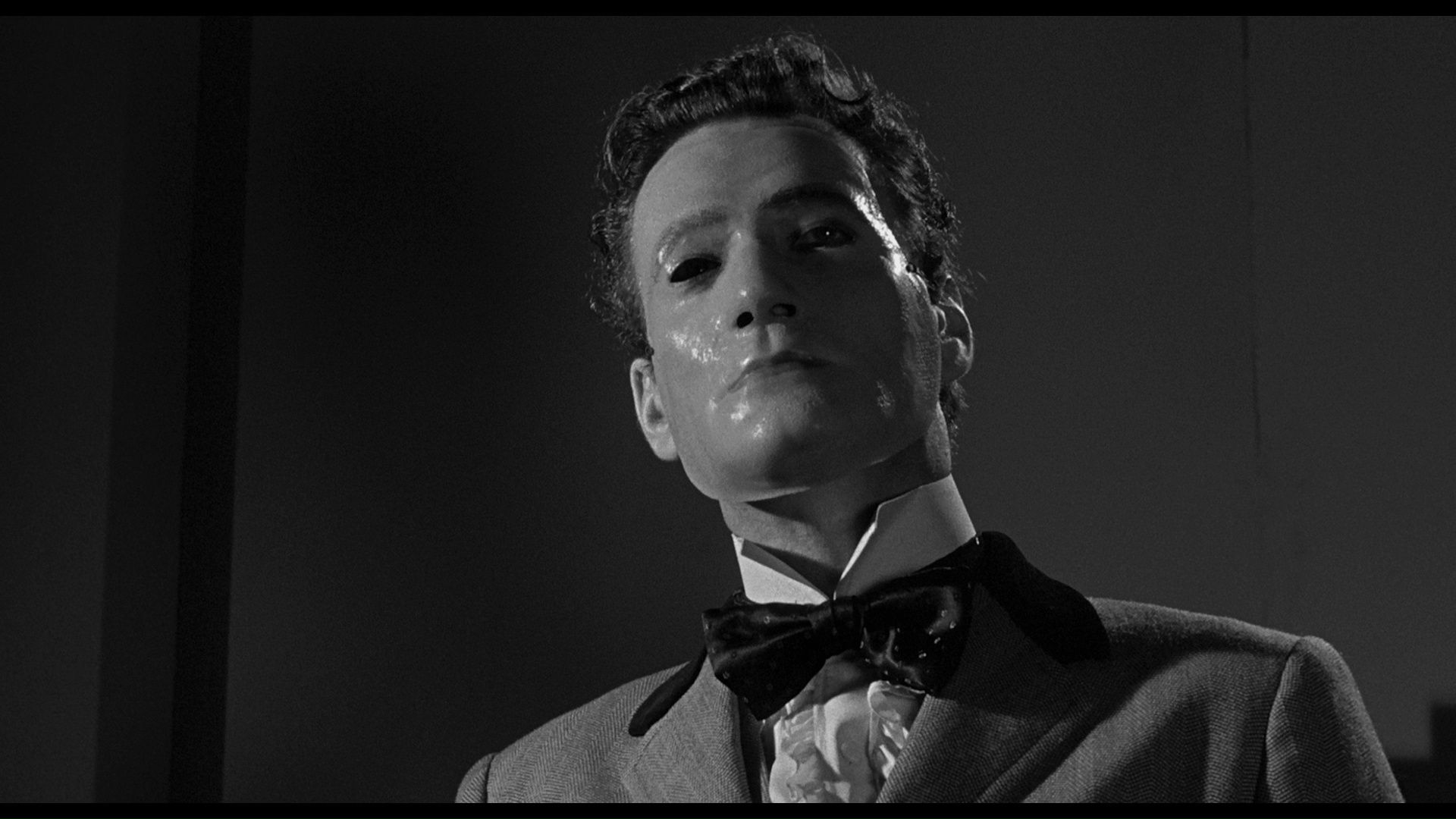 addition to his commercial instincts, the parallels to other films like Corridors of Blood, and the strength of many of his female protagonists. "Taking the Punishment Poll" is ported over here along with a superior new HD scan of the theatrical trailer, while the new "Gothic Castle" (27m51s) with Jonathan Rigby opens with the amusing analogy to "a polar bear leafing through Playboy by a swimming pool" (you'll have to watch to figure that one out) and explains how the Ray Russell novella was spun into a feature film with elements drawn from classics like Dracula. In "The Punishment Poll" (5m55s), Columbia's Richard Kahn appears in an archival interview about how the success of Alfred Hitchcock Presents spurred Castle's desire to appear on the screen for his gimmicks with a focus on the one used here, while the great Stuart Gordon hosts a Trailers from Hell version of the trailer. A 51-image gallery of stills and posters is also included. The limited edition box (6,000 units) also contains insert booklets featuring new liner notes essays by Ellinger, Dan Whitehead, Rebecca Nicole Williams and Jo Botting, as well as archival interviews, credits, and excerpts from critical reviews.
addition to his commercial instincts, the parallels to other films like Corridors of Blood, and the strength of many of his female protagonists. "Taking the Punishment Poll" is ported over here along with a superior new HD scan of the theatrical trailer, while the new "Gothic Castle" (27m51s) with Jonathan Rigby opens with the amusing analogy to "a polar bear leafing through Playboy by a swimming pool" (you'll have to watch to figure that one out) and explains how the Ray Russell novella was spun into a feature film with elements drawn from classics like Dracula. In "The Punishment Poll" (5m55s), Columbia's Richard Kahn appears in an archival interview about how the success of Alfred Hitchcock Presents spurred Castle's desire to appear on the screen for his gimmicks with a focus on the one used here, while the great Stuart Gordon hosts a Trailers from Hell version of the trailer. A 51-image gallery of stills and posters is also included. The limited edition box (6,000 units) also contains insert booklets featuring new liner notes essays by Ellinger, Dan Whitehead, Rebecca Nicole Williams and Jo Botting, as well as archival interviews, credits, and excerpts from critical reviews.